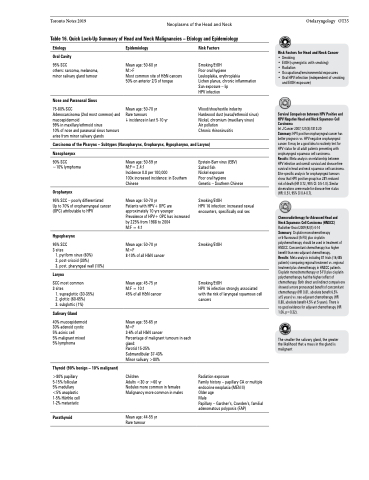Page 1021 - TNFlipTest
P. 1021
Toronto Notes 2019 Neoplasms of the Head and Neck Table 16. Quick Look-Up Summary of Head and Neck Malignancies – Etiology and Epidemiology
Otolaryngology OT35
Risk Factors for Head and Neck Cancer
• Smoking
• EtOH (synergistic with smoking)
• Radiation
• Occupational/environmental exposures
• Oral HPV infection (independent of smoking
and EtOH exposure)
Survival Comparison between HPV Positive and HPV Negative Head and Neck Squamous Cell Carcinoma
Int J Cancer 2007;121(8):1813-20
Summary: HPV positive oropharyngeal cancer has better prognosis vs. HPV negative oropharyngeal cancer. It may be a good idea to routinely test for HPV status for all adult patients presenting with oropharyngeal squamous cell carcinoma.
Results: Meta-analysis on relationship between HPV infection and overall survival and disease-free survival in head and neck squamous cell carcinoma. Site-specific analysis for oropharyngeal tumours show that HPV positive group has 28% reduced risk of death (HR 0.72, 95% CI: 0.5-1.0). Similar observations were made for disease-free status (HR: 0.51, 95% CI 0.4-0.7).
Chemoradiotherapy for Advanced Head and Neck Squamous Cell Carcinoma (HNSCC) Radiother Oncol 2009;92(1):4-14
Summary: Cisplatin monochemotherapy
or 5-fluorouracil (5-FU) plus cisplatin polychemotherapy should be used in treatment of HNSCC. Concomitant chemotherapy has higher benefit than neo-adjuvant chemotherapy.
Results: Meta-analysis including 87 trials (16,485 patients) comparing regional treatment vs. regional treatment plus chemotherapy in HNSCC patients. Cisplatin monochemotherapy or 5-FU plus cisplatin polychemotherapy had the highest effect of chemotherapy. Both direct and indirect comparisons showed a more pronounced benefit of concomitant chemotherapy (HR 0.81, absolute benefit 6.5%
at 5 years) vs. neo-adjuvant chemotherapy (HR 0.88, absolute benefit 4.5% at 5 years). There is
no good evidence for adjuvant chemotherapy (HR 1.06, p=0.32).
The smaller the salivary gland, the greater the likelihood that a mass in the gland is malignant
Etiology
Oral Cavity
95% SCC
others: sarcoma, melanoma, minor salivary gland tumour
Nose and Paranasal Sinus
75-80% SCC
Adenocarcinoma (2nd most common) and mucoepidermoid
99% in maxillary/ethmoid sinus
10% of nose and paranasal sinus tumours arise from minor salivary glands
Epidemiology
Mean age: 50-60 yr
M>F
Most common site of H&N cancers 50% on anterior 2/3 of tongue
Mean age: 50-70 yr
Rare tumours
iincidence in last 5-10 yr
Risk Factors
Smoking/EtOH
Poor oral hygiene
Leukoplakia, erythroplakia
Lichen planus, chronic inflammation Sun exposure – lip
HPV infection
Wood/shoe/textile industry Hardwood dust (nasal/ethmoid sinus) Nickel, chromium (maxillary sinus) Air pollution
Chronic rhinosinusitis
Carcinoma of the Pharynx – Subtypes (Nasopharynx, Oropharynx, Hypopharynx, and Larynx)
Nasopharynx
90% SCC
~10% lymphoma
Oropharynx
95% SCC – poorly differentiated
Up to 70% of oropharnyngeal cancer (OPC) attributable to HPV
Hypopharynx
95% SCC 3 sites
1. pyriform sinus (60%)
2. post-cricoid (30%)
3. post. pharyngeal wall (10%)
Larynx
SCC most common 3 sites
1. supraglottic (30-35%) 2. glottic (60-65%)
3. subglottic (1%)
Salivary Gland
40% mucoepidermoid 30% adenoid cystic 5% acinic cell
5% malignant mixed 5% lymphoma
Thyroid (90% benign – 10% malignant)
>80% papillary 5-15% follicular 5% medullary <5% anaplastic 1-5% Hürthle cell 1-2% metastatic
Parathyroid
Mean age: 50-59 yr
M:F= 2.4:1
Incidence 0.8 per 100,000
100x increased incidence: in Southern Chinese
Mean age: 50-70 yr
Patients with HPV+ OPC are approximately 10 yrs younger Prevalence of HPV+ OPC has increased by 225% from 1988 to 2004
M:F = 4:1
Mean age: 50-70 yr M>F
8-10% of all H&N cancer
Mean age: 45-75 yr M:F = 10:1
45% of all H&N cancer
Mean age: 55-65 yr
M=F
3-6% of all H&N cancer
Percentage of malignant tumours in each gland:
Parotid 15-25% Submandibular 37-43% Minor salivary >80%
Children
Adults <30 or >60 yr
Nodules more common in females Malignancy more common in males
Mean age: 44-55 yr Rare tumour
Epstein-Barr virus (EBV) Salted fish
Nickel exposure
Poor oral hygiene
Genetic – Southern Chinese
Smoking/EtOH
HPV 16 infection: increased sexual encounters, specifically oral sex
Smoking/EtOH
Smoking/EtOH
HPV 16 infection strongly associated with the risk of laryngeal squamous cell cancers
Radiation exposure
Family history – papillary CA or multiple endocrine neoplasia (MEN II)
Older age
Male
Papillary – Gardner’s, Cowden’s, familial adenomatous polyposis (FAP)


